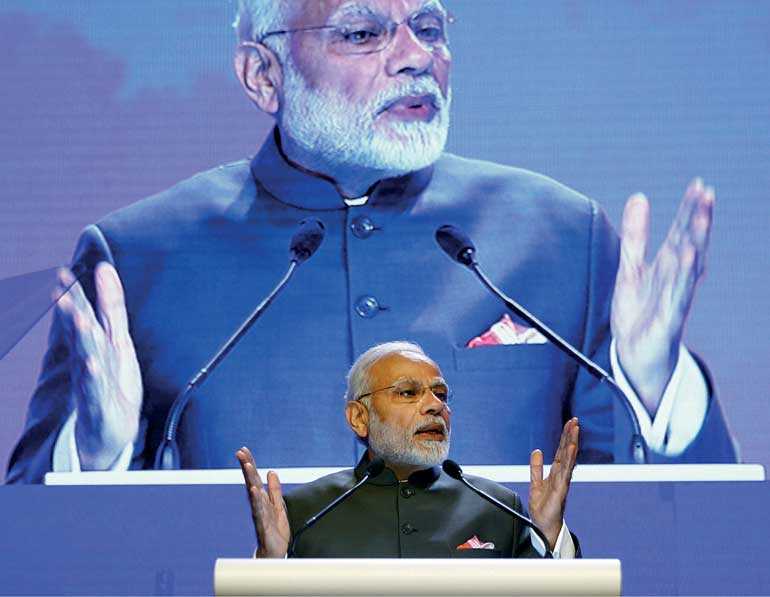Thursday Mar 06, 2025
Thursday Mar 06, 2025
Monday, 4 June 2018 00:00 - - {{hitsCtrl.values.hits}}

India’s Prime Minister Narendra Modi delivers the keynote address at the IISS Shangri-la Dialogue in Singapore - REUTERS
Singapore (Reuters): Indian Prime Minister Narendra Modi called for equal access at sea and in the air for all Asian countries at a major defence conference on Friday (1 June), but avoided singling out China’s claims to the hotly contested South China Sea.
Modi outlined his regional vision at the annual Shangri-La Dialogue in Singapore, attended by defence chiefs from over 40 countries, including US Defense Secretary Jim Mattis.
The Indian leader’s visit to Southeast Asia, which he described as the centre of a new era of cooperation in a region that spanned the coast of Africa to the US West Coast, comes amid growing unease about China’s growing naval assertiveness.
The region is also caught up in what could be a global trade conflict after the US Trump administration said it would follow through on its threat of tariffs on $50 billion worth of Chinese imports. Washington and Beijing have threatened tit-for-tat tariffs on goods worth up to $150 billion each.
“India does not see the Indo-Pacific region as a strategy or a club of limited members ... and by no means do we consider it directed at any country,” Modi said in a keynote address to the forum.”We should all have equal access and the right under international law to the use of common spaces on the sea and in the air that will require freedom of navigation, unimpeded commerce and peaceful settlement of disputes in accordance with international law.”
The term “Indo-Pacific” has grown in usage across diplomatic and security circles in the United States, Australia, India and Japan in recent years, shorthand for a broader and democratic-led region in place of “Asia-Pacific”, which some people have said places China too firmly at the centre.
In a nod to India’s growing regional stature, the US military’s Pacific Command in Hawaii formally changed its name to the US Indo-Pacific Command in a ceremony on Wednesday (30 May). “India stands for (an) open and stable international trade regime,” Modi said. “We will also support a rules-based, open, balanced and stable trade environment in the Indo-Pacific region.”
In his four years in power, the Indian leader has sought to assert an expanded security role for his country in the Indo-Pacific, actively courting the 10-member Association of Southeast Asian Nations (ASEAN) and gradually stepping up naval activity across the Indian and Pacific oceans.
On Wednesday, Modi met Indonesian President Joko Widodo and pledged to develop infrastructure and an economic zone at Sabang, on the northern tip of Sumatra Island at the mouth of the Malacca Strait, one of the world’s busiest shipping lanes.
Modi stopped in Kuala Lumpur briefly on Thursday (31 May) to meet newly elected Malaysian Prime Minister Mahathir Mohamad before arriving in Singapore.
Modi’s talks with Singapore Prime Minister Lee Hsien Loong earlier on Friday included an agreement for greater engagement between their navies, including exercises.
“Both prime ministers further agreed to India’s proposal for continuous and institutionalised naval engagements in their shared maritime space, including the establishment of maritime exercises with like-minded regional partners,” the Singapore Defence Ministry said in a statement.
In January, Modi invited the leaders of all 10 ASEAN countries to India’s Republic Day parade in New Delhi, the biggest such gathering of foreign leaders at the event.
Discover Kapruka, the leading online shopping platform in Sri Lanka, where you can conveniently send Gifts and Flowers to your loved ones for any event including Valentine ’s Day. Explore a wide range of popular Shopping Categories on Kapruka, including Toys, Groceries, Electronics, Birthday Cakes, Fruits, Chocolates, Flower Bouquets, Clothing, Watches, Lingerie, Gift Sets and Jewellery. Also if you’re interested in selling with Kapruka, Partner Central by Kapruka is the best solution to start with. Moreover, through Kapruka Global Shop, you can also enjoy the convenience of purchasing products from renowned platforms like Amazon and eBay and have them delivered to Sri Lanka.
Discover Kapruka, the leading online shopping platform in Sri Lanka, where you can conveniently send Gifts and Flowers to your loved ones for any event including Valentine ’s Day. Explore a wide range of popular Shopping Categories on Kapruka, including Toys, Groceries, Electronics, Birthday Cakes, Fruits, Chocolates, Flower Bouquets, Clothing, Watches, Lingerie, Gift Sets and Jewellery. Also if you’re interested in selling with Kapruka, Partner Central by Kapruka is the best solution to start with. Moreover, through Kapruka Global Shop, you can also enjoy the convenience of purchasing products from renowned platforms like Amazon and eBay and have them delivered to Sri Lanka.